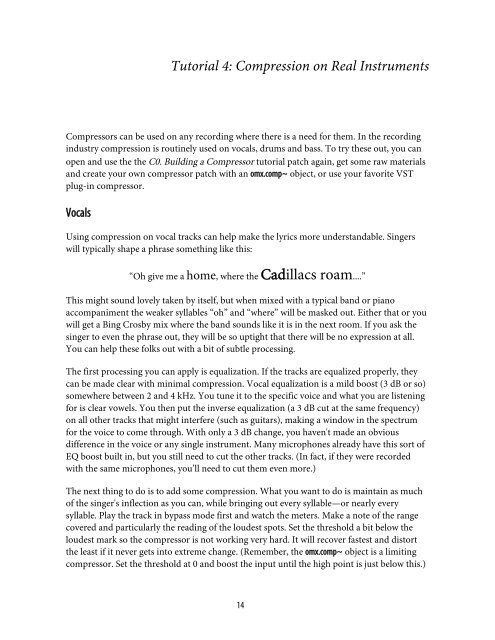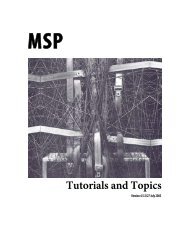MSP; "A Primer on Compression" - Peabody Computer Music
MSP; "A Primer on Compression" - Peabody Computer Music
MSP; "A Primer on Compression" - Peabody Computer Music
You also want an ePaper? Increase the reach of your titles
YUMPU automatically turns print PDFs into web optimized ePapers that Google loves.
Tutorial 4: Compressi<strong>on</strong> <strong>on</strong> Real InstrumentsCompressors can be used <strong>on</strong> any recording where there is a need for them. In the recordingindustry compressi<strong>on</strong> is routinely used <strong>on</strong> vocals, drums and bass. To try these out, you canopen and use the the C0. Building a Compressor tutorial patch again, get some raw materialsand create your own compressor patch with an omx.comp~ object, or use your favorite VSTplug-in compressor.VocalsUsing compressi<strong>on</strong> <strong>on</strong> vocal tracks can help make the lyrics more understandable. Singerswill typically shape a phrase something like this:“Oh give me a home, where the Cadillacs roam....”This might sound lovely taken by itself, but when mixed with a typical band or pianoaccompaniment the weaker syllables “oh” and “where” will be masked out. Either that or youwill get a Bing Crosby mix where the band sounds like it is in the next room. If you ask thesinger to even the phrase out, they will be so uptight that there will be no expressi<strong>on</strong> at all.You can help these folks out with a bit of subtle processing.The first processing you can apply is equalizati<strong>on</strong>. If the tracks are equalized properly, theycan be made clear with minimal compressi<strong>on</strong>. Vocal equalizati<strong>on</strong> is a mild boost (3 dB or so)somewhere between 2 and 4 kHz. You tune it to the specific voice and what you are listeningfor is clear vowels. You then put the inverse equalizati<strong>on</strong> (a 3 dB cut at the same frequency)<strong>on</strong> all other tracks that might interfere (such as guitars), making a window in the spectrumfor the voice to come through. With <strong>on</strong>ly a 3 dB change, you haven't made an obviousdifference in the voice or any single instrument. Many microph<strong>on</strong>es already have this sort ofEQ boost built in, but you still need to cut the other tracks. (In fact, if they were recordedwith the same microph<strong>on</strong>es, you’ll need to cut them even more.)The next thing to do is to add some compressi<strong>on</strong>. What you want to do is maintain as muchof the singer's inflecti<strong>on</strong> as you can, while bringing out every syllable—or nearly everysyllable. Play the track in bypass mode first and watch the meters. Make a note of the rangecovered and particularly the reading of the loudest spots. Set the threshold a bit below theloudest mark so the compressor is not working very hard. It will recover fastest and distortthe least if it never gets into extreme change. (Remember, the omx.comp~ object is a limitingcompressor. Set the threshold at 0 and boost the input until the high point is just below this.)14
















